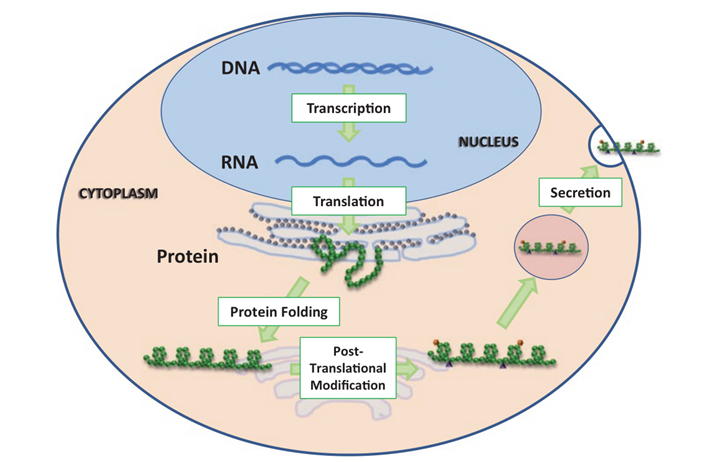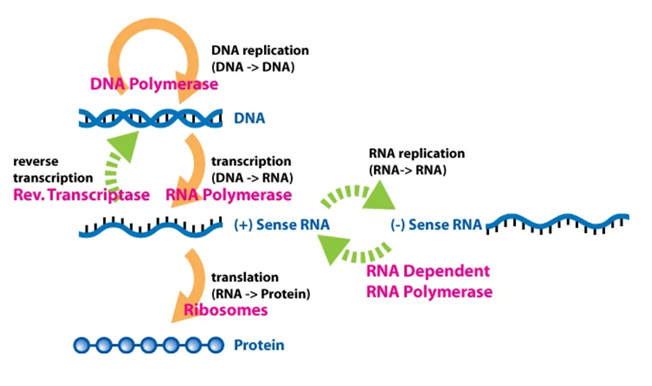An Introduction To Recombinant Protein
Protein expression is a critical biological process that involves the synthesis, folding, localization, and regulation of proteins in response to the functional demands of the body. It represents the dynamic output of the genome, where specific proteins are produced to meet cellular and physiological needs. This process is essential in biological research and biotechnology, yet it is tightly regulated and often poses significant challenges due to the complex interplay of multiple factors, including chromatin state, transcriptional activity, mRNA translation, post-translational modifications (PTMs), and protein degradation pathways.

Fundamentals of Protein Expression
The fundamentals of protein expression revolve around the central dogma of molecular biology, which states that genetic information flows from DNA to RNA and then to protein. This process is foundational to understanding genetics and molecular biology, both of which are crucial in modern research across various fields.

Transcription and Translation Processes
Protein synthesis is a vital process that underpins the structural and functional aspects of life. It includes several key steps:
- Transcription: Within the nucleus, DNA is transcribed into a complementary messenger RNA (mRNA) strand by RNA polymerase.
- Post-transcriptional modifications:
- Splicing: Introns (non-coding regions) are removed, and exons (coding regions) are joined to form a mature mRNA.
- Capping: A 5' cap is added to protect the mRNA and assist in ribosome binding during translation.
- Polyadenylation: A poly-A tail is added to the 3' end to stabilize the mRNA and regulate its lifespan.
- Translation: In the cytoplasm, ribosomes read the mRNA sequence to synthesize a polypeptide chain, using transfer RNAs (tRNAs) to bring the corresponding amino acids.
- Post-translational modifications (PTMs): The synthesized polypeptide undergoes modifications such as folding, phosphorylation, glycosylation, or cleavage to become a functional protein.
Endogenous vs. Recombinant Protein Expression
Protein expression can be categorized into two types: endogenous and recombinant. Endogenous protein expression occurs naturally within organisms under normal biological conditions, while recombinant protein expression involves producing proteins using genetically engineered systems. Both types are widely used in scientific applications. Endogenous expression helps researchers study native protein functions, whereas recombinant expression is utilized for large-scale protein production for research and therapeutic purposes. Visit our website to find the perfect proteins for your target.
Applications of Protein Expression Systems
Protein expression systems have a wide range of applications across various industries. In the biopharmaceutical sector, they are used to produce monoclonal antibodies, recombinant hormones, vaccines, and therapeutic enzymes.
Industrially, these systems are employed to manufacture enzymes for detergents, biofuels, food processing, and bioplastics.
In research, protein expression systems facilitate studies on protein structure, synthetic biology, and gene editing tools like CRISPR.
Agricultural applications include the development of genetically modified crops and veterinary vaccines.
In diagnostics, these systems are used to produce reagents for tests and to develop biosensors. Additionally, they enable protein engineering, biomaterial production, bioremediation, and carbon capture, driving innovation in environmental sustainability.
Conclusion
Protein expression is a multifaceted process that is fundamental to life and has far-reaching implications in both research and industry. Understanding the intricacies of protein synthesis, from transcription to translation and post-translational modifications, is crucial for advancing our knowledge of biology and developing new technologies. The diverse applications of protein expression systems highlight their importance in addressing global challenges in healthcare, agriculture, and environmental sustainability.
References
Ruizhao Jiang and Shuting Yuan. (2024) Strategies to overcome the challenges of low or no expression of heterologous proteins in Escherichia coli. Biotechnology Advances. https://doi.org/10.1016/j.biotechadv.2024.108417
Paula Meleady (ed.), Heterologous Protein Production in CHO Cells: Methods and Protocols. Methods in Molecular Biology. vol. 1603, DOI 10.1007/978-1-4939-6972-2_1
 | Dylan Z Dylan Z is a protein & antibody expert at EnkiLife, proficient in protein expression systems and antibody preparation techniques. He strives for excellence in technology and is committed to developing stable and user-friendly products for users. |
